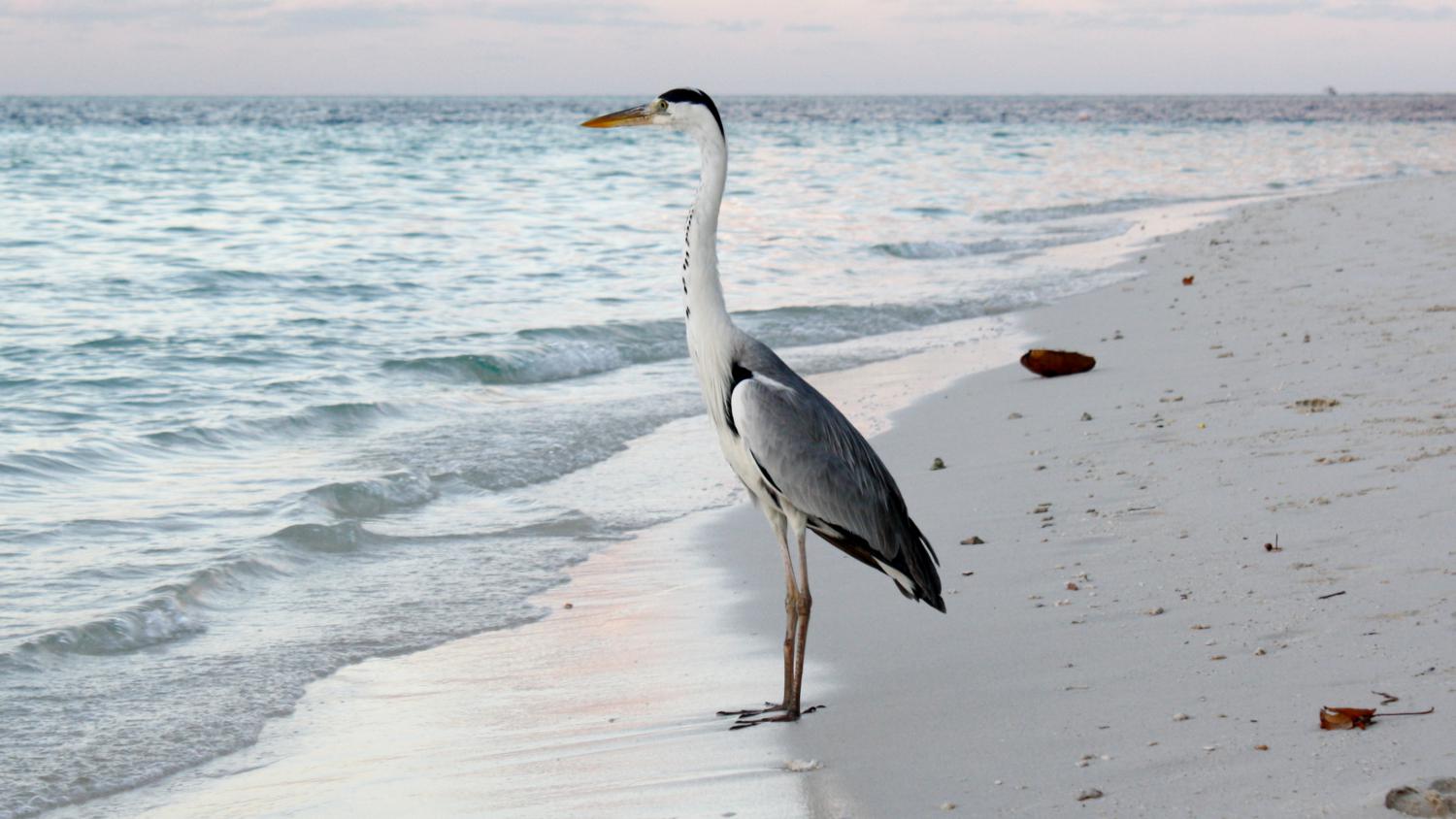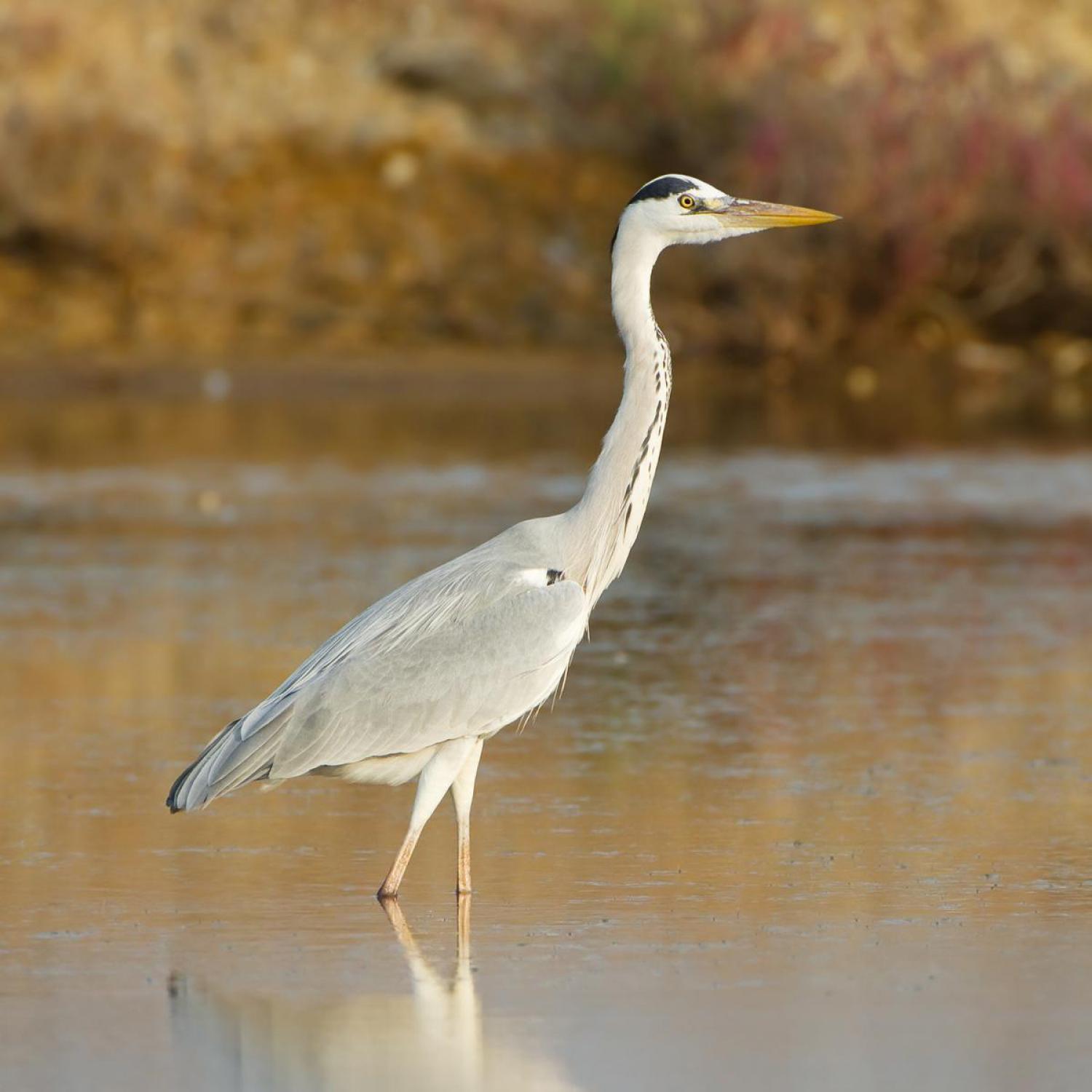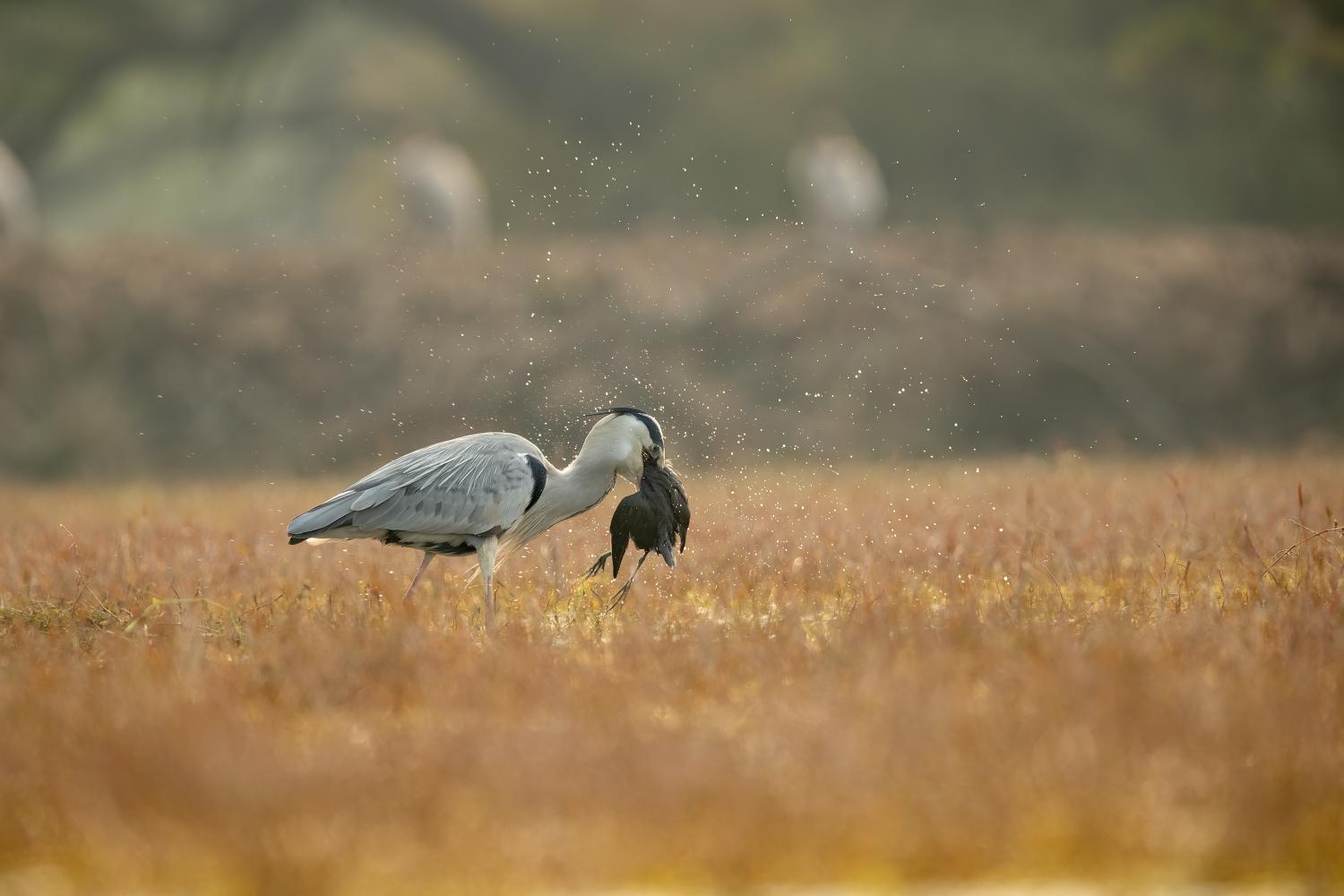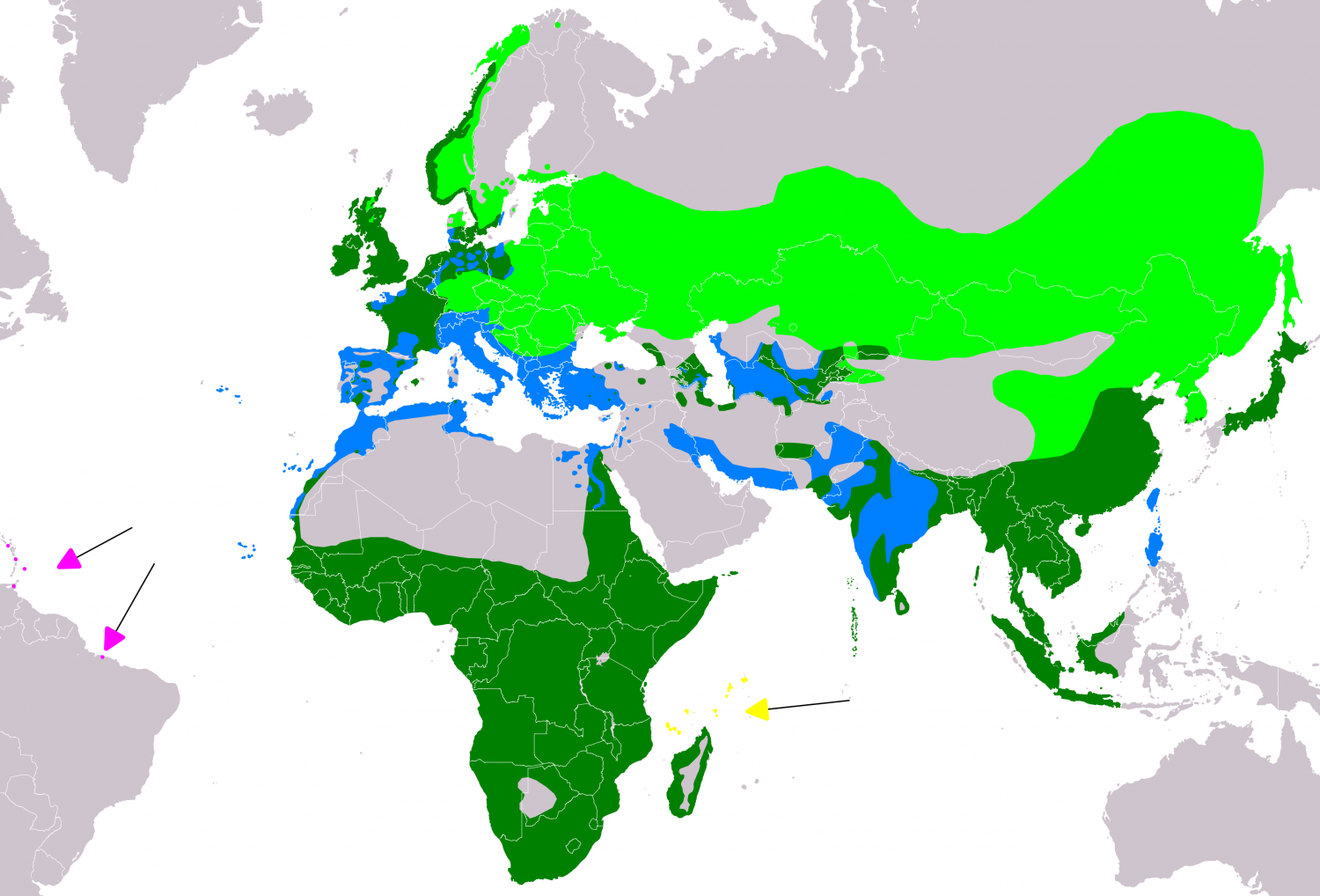Species of Thailand
Grey heron
Ardea cinerea
Carolus Linnaeus, 1758
In Thai: นกกระสานวล
The grey heron (Ardea cinerea), is a wading bird of the heron family Ardeidae, native throughout temperate Europe and Asia and also parts of Africa. It is resident in the milder south and west, but many birds retreat in winter from the ice in colder regions. It has become common in summer even inside the Arctic circle along the Norwegian coast.
Description
It is a large bird, standing up to 100 cm tall and measuring 84 - 102 cm long with a 155 – 195 cm wingspan. The body weight can range from 1.02 – 2.08 kg. Its plumage is largely grey above, and off-white below. Adults have a white head with a broad black supercilium and slender crest, while immatures have a dull grey head. It has a powerful, pinkish-yellow bill, which is brighter in breeding adults. It has a slow flight, with its long neck retracted (S-shaped). This is characteristic of herons and bitterns, and distinguishes them from storks, cranes and spoonbills, which extend their necks. The call is a loud croaking "fraaank". The Australian white-faced heron is often incorrectly called a grey heron. In Ireland, the grey heron is often colloquially called a "crane".
Food and feeding
It feeds in shallow water, catching fish, frogs, and insects with its long bill. Herons will also take small mammals and reptiles. They have also been observed catching and killing juvenile birds such as ducklings, and occasionally take birds up to the size of a water rail. Due to its S-shaped neck, the bird is able to strike with the bill very rapidly. It will often wait motionless for prey, or slowly stalk its victim.
City life
Grey herons have been able to live in cities where habitats and nesting space are available.
In the Netherlands, the grey heron has established itself over the past decades in great numbers in urban environments. In cities like Amsterdam, they are ever present and well adapted to modern city life. They hunt as usual but also visit street markets and snackbars. Some individuals make use of people feeding them at their homes or recreational fishermen to share their catch. Similar behaviour on a smaller scale has been reported in Ireland.
Herons have also been observed colonising water enclosures in zoos, such as spaces for penguins, otters, pelicans and seals, and taking food meant for the animals on display. Such behaviour has been noted in zoos in Vienna, London and Amsterdam.
Breeding
This species breeds in colonies (heronries) in trees close to lakes, the seashore or other wetlands, although it will also nest in reedbeds. It builds a bulky stick nest.
Parasites
A thorough study performed by J. Sitko and P. Heneberg in the Czech Republic in years 1962-2013 suggested that the central European grey herons host 29 helminth species. The dominant species consisted of Apharyngostrigea cornu (67% prevalence), Posthodiplostomum cuticola (41% prevalence), Echinochasmus beleocephalus (39% prevalence), Uroproctepisthmium bursicola (36% prevalence), Neogryporhynchus cheilancristrotus (31% prevalence), Desmidocercella numidica (29% prevalence) and Bilharziella polonica (5% prevalence). Juvenile grey herons were shown to host fewer species, but the intensity of infection was higher in the juveniles than in the adult herons. Of the digeneans found in central European grey herons, 52% of the species likely infected their definitive hosts outside of the central Europe itself, i.e., in the premigratory, migratory or wintering quarters despite the fact that a substantial part of grey herons do not migrate to the South, particularly in recently repeatedly occurring warm winters
This article uses material from Wikipedia released under the Creative Commons Attribution-Share-Alike Licence 3.0. Eventual photos shown in this page may or may not be from Wikipedia, please see the license details for photos in photo by-lines.
Category / Seasonal Status
Wiki listed status (concerning Thai population): Winter visitor, formerly bred
BCST Category: Recorded in an apparently wild state within the last 50 years
BCST Seasonal statuses:
- Resident or presumed resident
- Non-breeding visitor
Scientific classification
- Kingdom
- Animalia
- Phylum
- Chordata
- Class
- Aves
- Order
- Pelecaniformes
- Family
- Ardeidae
- Genus
- Ardea
- Species
- Ardea cinerea
Common names
- Thai: นกกระสานวล
Subspecies
Ardea cinerea cinerea (nominate), Carolus Linnaeus, 1758
Range: Europe, Africa, western Asia
Ardea cinerea firasa, Ernst Johann Otto Hartert, 1917
Range: Madagascar
Ardea cinerea jouyi, Austin Hobart Clark, 1907
Range: Eastern Asia
Ardea cinerea monicae, Christian Jouanin & Francis Roux, 1963
Range: Islands off Banc d'Arguin, Mauritania.
Conservation status

Least Concern (IUCN3.1)

Extinct (ONEP)
- EX (resident)/LC (migratory) -
Photos
Please help us review the bird photos if wrong ones are used. We can be reached via our contact us page.
Range Map

- Amphawa District, Samut Songkhram
- Ban Laem District, Phetchaburi
- Ban Lueam District, Nakhon Ratchasima
- Ban Phai District, Khon Kaen
- Ban Sang District, Prachinburi
- Bang Ban District, Phra Nakhon Si Ayutthaya
- Bang Kruai District, Nonthaburi
- Bang Len District, Nakhon Pathom
- Bang Pahan District, Phra Nakhon Si Ayutthaya
- Bang Pakong District, Chachoengsao
- Bang Phra Non-Hunting Area
- Bang Pu Recreation Centre
- Bangkok Province
- Borabue District, Maha Sarakham
- Bueng Boraped Non-Hunting Area
- Chai Badan District, Lopburi
- Chaiyo District, Ang Thong
- Chatturat District, Chaiyaphum
- Chiang Dao District, Chiang Mai
- Chiang Saen District, Chiang Rai
- Dan Chang District, Suphan Buri
- Doi Inthanon National Park
- Doi Lo District, Chiang Mai
- Doi Pha Hom Pok National Park
- Doi Suthep - Pui National Park
- Doi Tao District, Chiang Mai
- Don Chedi District, Suphan Buri
- Fang District, Chiang Mai
- Hala-Bala Wildlife Sanctuary
- Hat Yai District, Songkhla
- Huai Chorakhe Mak Reservoir Non-Hunting Area
- Huai Sala Wildlife Sanctuary
- Huai Talat Reservoir Non-Hunting Area
- In Buri District, Sing Buri
- Kabin Buri District, Prachinburi
- Kaeng Khoi District, Saraburi
- Kaeng Krachan National Park
- Kamphaeng Saen District, Nakhon Pathom
- Kantharawichai District, Maha Sarakham
- Khao Nang Phanthurat Forest Park
- Khao Sam Roi Yot National Park
- Khao Sok National Park
- Khao Yai National Park
- Khao Yoi District, Phetchaburi
- Khemarat District, Ubon Ratchathani
- Khon San District, Chaiyaphum
- Khuan Khanun District, Phatthalung
- Khura Buri District, Phang Nga
- Klaeng District, Rayong
- Ko Lanta National Park
- Ko Phayam
- Ko Samui District, Surat Thani
- Ko Sichang District, Chonburi
- Kumphawapi District, Udon Thani
- Kut Thing Non-Hunting Area
- Laem Pak Bia
- Laem Son National Park
- Mae Ai District, Chiang Mai
- Mae Chan District, Chiang Rai
- Mae Mo District, Lampang
- Mae Rim District, Chiang Mai
- Mae Taeng District, Chiang Mai
- Mueang Buriram District, Buriram
- Mueang Chiang Mai District, Chiang Mai
- Mueang Chiang Rai District, Chiang Rai
- Mueang Chonburi District, Chonburi
- Mueang Kalasin District, Kalasin
- Mueang Khon Kaen District, Khon Kaen
- Mueang Krabi District, Krabi
- Mueang Lamphun District, Lamphun
- Mueang Nakhon Nayok District, Nakhon Nayok
- Mueang Nakhon Pathom District, Nakhon Pathom
- Mueang Nakhon Ratchasima District, Nakhon Ratchasima
- Mueang Nonthaburi District, Nonthaburi
- Mueang Pathum Thani District, Pathum Thani
- Mueang Pattani District, Pattani
- Mueang Phayao District, Phayao
- Mueang Phetchaburi District, Phetchaburi
- Mueang Phichit District, Phichit
- Mueang Phitsanulok District, Phitsanulok
- Mueang Phuket District, Phuket
- Mueang Ratchaburi District, Ratchaburi
- Mueang Samut Sakhon District, Samut Sakhon
- Mueang Samut Songkhram District, Samut Songkhram
- Mueang Suphanburi District, Suphan Buri
- Mueang Surat Thani District, Surat Thani
- Mueang Surin District, Surin
- Mueang Tak District, Tak
- Mueang Udon Thani District, Udon Thani
- Mueang Uttaradit District, Uttaradit
- Non Thai District, Nakhon Ratchasima
- Nong Bong Khai Non-Hunting Area
- Nong Han Lake
- Nong Song Hong District, Khon Kaen
- Nong Ya Plong District, Phetchaburi
- Pak Chong District, Nakhon Ratchasima
- Pak Phli District, Nakhon Nayok
- Pak Thale
- Pha Daeng National Park
- Pha Taem National Park
- Phaisali District, Nakhon Sawan
- Phanat Nikhom District, Chonburi
- Phra Nakhon Si Ayutthaya District, Phra Nakhon Si Ayutthaya
- Phu Khiao Wildlife Sanctuary
- Phutthamonthon District, Nakhon Pathom
- Pran Buri District, Prachuap Khiri Khan
- Sai Noi District, Nonthaburi
- Samut Prakan Province
- San Sai District, Chiang Mai
- Sanam Bin Reservoir Non-Hunting Area
- Sanam Chai Khet District, Chachoengsao
- Sathing Phra District, Songkhla
- Sri Phang-nga National Park
- Takua Pa District, Phang Nga
- Taphan Hin District, Phichit
- Tha Sala District, Nakhon Si Thammarat
- Tha Yang District, Phetchaburi
- Thai Mueang District, Phang Nga
- Thale Noi Non-Hunting Area
- Than Sadet - Koh Pha-Ngan National Park
- Thanyaburi District, Pathum Thani
- Wang Noi District, Phra Nakhon Si Ayutthaya
- Wat Phai Lom & Wat Ampu Wararam Non-Hunting Area
- Wiang Chai District, Chiang Rai




